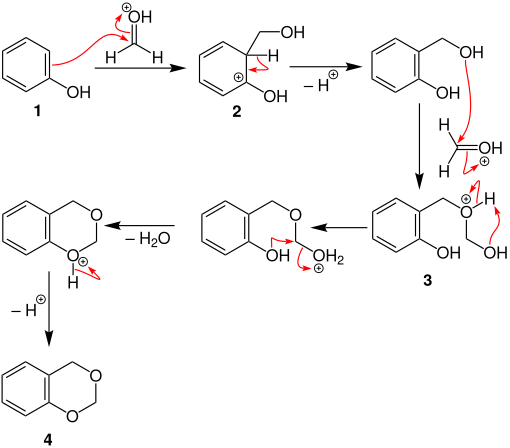Borsche-Berkhout reaction
The Borsche-Berkhout reaction , named after the chemists Walther Borsche and AD Berkhout , is a name reaction from the field of organic chemistry and was first described in 1904. The Borsche-Berkhout reaction enables the preparation of 1,3-benzodioxane from phenols and aldehydes .
Overview reaction
Phenols can be reacted with aldehydes in an acid-catalyzed reaction to form 1,3-benzodioxane:
The reaction can also be carried out with additionally substituted phenols and other aldehydes. 1,3-Benzodioxane can then be further oxidized to lactones :
Reaction mechanism
The following reaction mechanism is described in the literature:
In the first step the carbonyl group of the aldehyde is protonated. With the protonated aldehyde, intermediate stage 2 is formed with the loss of the aromaticity of phenol ( 1 ) . Then, through deprotonation , rearomatization occurs. In the next step, the hydroxyl group can attack another protonated aldehyde, creating the oxonium ion 3 . Finally, with elimination of water, the ring closes and, after further deprotonation, 1,3-benzodioxane is formed ( 4 ).
Individual evidence
- ↑ W. Borsche and AD Berkhout: On the action of formaldehyde on p-nitrophenols. In: Justus Liebigs Ann. Chem. 330, 1904, pp. 82-107, doi: 10.1002 / jlac.19043300107 .
- ^ A b Zerong Wang: Comprehensive Organic Name Reactions and Reagents. Wiley, 2009, ISBN 978-0-471-70450-8 , pp. 468-470.
- ↑ CA Buehler, B. Calvin Bass, Robert B. Darling and Milton E. Lubs: Proof of Structure of 6-Chloro-8-chloromethyl-1,3-benzodioxane by Oxidation. In: J. Am. Chem. Soc. 62, 1940, pp. 890-894, doi: 10.1021 / ja01861a049 .
- ^ CA Buehler, Archie V. Slack, DA Shirley, Philip A. Sanguinetti, and Sheldon H. Frey: The Action of Formaldehyde on m-Hydroxybenzoic Acid. III. Stepwise Degradation of the Lactones of 6-Hydroxymethyl-1,3-Benzodioxane-5-Carboxylic Acid. In: J. Am. Chem. Soc. 73, 1951, pp. 2347-2349, doi: 10.1021 / ja01149a133 .

